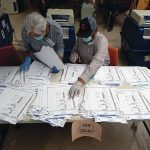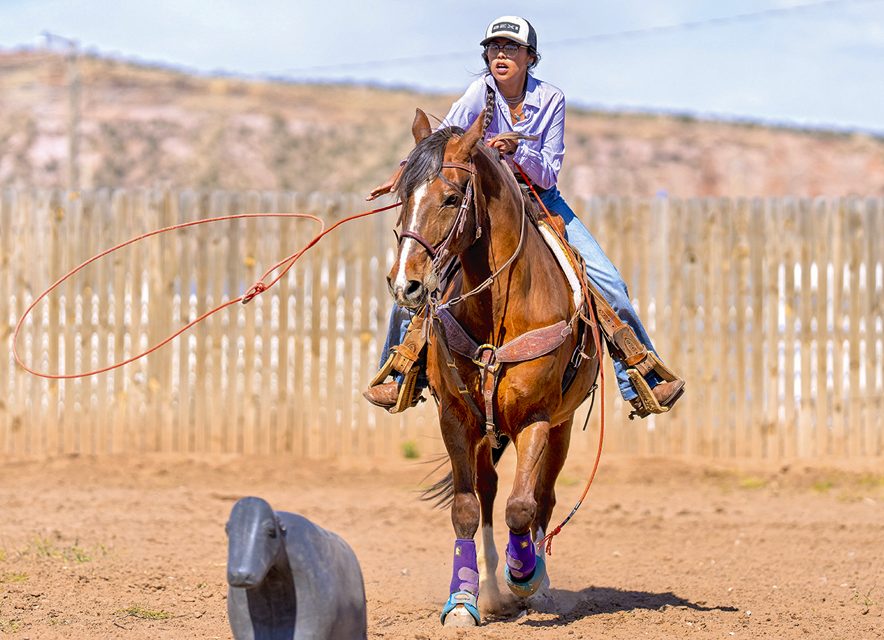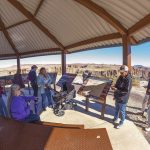
Legacy of tradition, conservation, and community resilience

Special to the Times | Donovan Quintero
Amree Peralto from Fort Apache, Arizona, throws her lasso at the dummy calf at the Dean C. Jackson Memorial Arena in Window Rock.
WINDOW ROCK
Before the sun rose over the mesas of northeast Arizona, Amy George and her daughters, Amree, and Bernaya Peralto, were already on the road.
At 3:30 a.m., they left their ranch on the Fort Apache Indian Reservation to attend a youth rodeo clinic at the Dean C. Jackson Memorial Arena in Window Rock. PRCA world champion Navajo cowboy Aaron Tsinigine hosted the clinic. It featured breakaway ropers Danielle Lowman and Kassidy Dennison—professional Native athletes who returned home to teach the next generation.
For 17-year-old Amree, the clinic was an opportunity to refine her horsemanship and rodeo techniques. But for her mother, it also reminded her how rodeo, ranching, and tradition are woven into their family’s identity and survival.
“My daughter’s a third-generation cowgirl,” George said as the arena buzzed with activity. “I grew up doing the Indian junior rodeos. My dad, Monty George, rodeoed too. We live on a ranch and see the importance of getting up early in the morning to care for your animals. It’s not just physical—it is mental and spiritual, too. That all ties into who you are.”
George and her daughters live on about 15 acres, raising cattle, horses, goats, and chickens and maintaining a backyard garden. But after years of drought, the physical demands of ranch life have only intensified.
“We’ve had to hold back on planting a lot this year,” she said. “We haven’t had any moisture at home. I have to ask myself—how am I going to provide the corn or the beans we need? It’s a community concern now. If someone lives closer to the river, I hope they can help those of us who can’t plant as much.”

Special to the Times | Donovan Quintero
Professional rodeo athlete Kassidy Dennison speaks to young rodeo athletes about what kind of attitude best suits them if they intend to become future world champions, during a clinic on breakaway roping and tie down roping at the Dean C. Jackson Memorial Arena in Window Rock.
The nearby White River, East Fork, North Fork, and Diamond Creek are now low-running streams. George said the dwindling snowpack from the White Mountains has severely reduced runoff, raising fears of another catastrophic fire like the one that struck in 2001.
Her family has responded by installing water storage tanks, using mulch to conserve moisture, and switching to garden boxes and container planting to reduce water use. As a grant writer for the People’s Farm, George teaches other families these water-saving methods.
“Instead of planting a whole cornfield, we teach families to start with a garden box,” she said. “That way, they can still grow food while conserving water.”
Her 19-year-old daughter, Bernaya, said those lessons—ranching, prayer, and tradition—have shaped how she views the world.
“From an early age, we were taught hard work—getting up early and feeding your animals before yourself,” she said. “A lot of kids my age weren’t raised like that. I feel like some lack that kind of guidance.”
The Peralto children were raised with both Christian and traditional teachings. Bernaya said that dual upbringing helped ground them.
“Our parents taught us how to pray and raised us with our traditional teachings. That shaped who we are,” she said.
The family’s values extend to their animals. Amy said she teaches her children that their horses, like people, require patience, trust, and care.
“If a horse does not want to do something, something is wrong. So, we take a step back, we evaluate, we give them trust. They’re smart. They feel just like we do,” George said. “Let’s share that love with our animals. Make sure they’re fed, vaccinated, and cared for.”
Their approach to horsemanship has produced results. The family bought Amree’s barrel racing horse for just $500, and she has trained it into a consistent 1D and 2D competitor.
“That says a lot about determination,” George said.
For George, what’s in the trailer matters more than what is pulling it.
“It’s not what you’re driving—it’s what’s in the trailer,” she said. “That horse that you’ve worked on from the ground up, that’s what matters.”
Even in the rodeo arena, George said character counts more than placement.
“I tell my daughters, whether you win or lose in the arena, walk out with who you are on the inside,” she said. “People will remember your character, not just your performance.”
As a mother and mentor, George said one of the biggest challenges in her community is helping young people find their identity, especially those who are disconnected from their language and culture.
“I feel like when a child understands or speaks their Native language, they feel a stronger sense of belonging,” she said. “Language connects you back to who you are.”
Bernaya agreed, noting that tradition and responsibility give her purpose in a generation raised on smartphones and social media.
“It gives you a sense of belonging, makes you feel more connected to Mother Earth,” she said. “Our parents taught us how to pray. They raised us with traditional teachings. That shaped who we are today.”
Amy George said technology could also support cultural resilience if Native youth had safe spaces to share stories, learn, and relate to one another.
“Our teachings are oral,” Bernaya said. “Maybe there’s a way to use technology so Native kids can connect with each other in our way.”
At the heart of the family’s values is a quiet consistency: waking up with gratitude, sharing love and responsibility, and remembering the past while building for the future.
“When it comes to being a competitor, a farmer, or a rancher—whatever it is you do—always remember where you come from,” George said. “Wake up with a grateful heart. Even if you don’t speak your Native language, try to learn. Know your clans. That gives you a sense of belonging.”
That sense of belonging at the arena deepened as George and her daughters joined dozens of other youth and families learning from Native rodeo champions.
Danielle Lowman, a professional breakaway roper, encouraged the young athletes to remain grounded and driven.
“You guys are the only people out here that are going to do it for yourselves,” she told them. “It’s all up to you. Whatever you want to be, it is up to you. You can do it as long as you believe it.”
She stressed discipline, remembering mistakes, and staying committed to foundational skills like roping the dummy and trusting the process.
“If you have a goal, you have a mind, you believe in yourself—push yourself to be the best you can,” she said. “That’ll help you in the long run.”
Tsinigine, who organized the clinic, thanked everyone who helped make it happen—including families, sponsors, and volunteers.
“I want you guys to leave here thankful,” he told the group. “Thank your parents. Thank your coaches. And if you took even one thing from today, carry that forward. I hope to see you in the results someday.”
He explained why they spent more time on groundwork than roping live cattle: safety, horsemanship, and respect for the process.
“To me, groundwork is more important than just roping. That is where you learn how to ride a horse,” he said. “I never had an arena growing up. It was just sand dunes and bare ground.”
He reminded the kids that the clinic’s professionals hadn’t been paid to show up—they came because they believed in the youth.
“No one gave them money to learn this knowledge,” he said. “It’s their own free will. That’s why they’re here teaching you.”
Dennison told the group to be kind to themselves, even on hard practice days.
“A true champion knows how to move on,” she said. “Sometimes we have the worst practice days. But the joy for me today was seeing each and every one of you improve in your way.”
She reminded them that mistakes are part of growth.
“Just get to the next hour, to the next rodeo, and just keep going. That’s what champions do,” she said.
The clinic, sponsored by Native Land Insurance and supported by families from across the region, marked the first of what Tsinigine hopes will become an annual tradition.
“Hopefully, in the next year or so, it’ll get bigger and better,” he said. “But this is only the first year. We’ll add more events as we move on.”
As families loaded up their trailers, Amy George looked on with pride—not just in her daughters but in the community’s coming together to support them.
“It means a lot,” she said. “Knowing where you came from and how you grew up—that’s what’s going to take you forward.”








 Highway 264,
Highway 264, I-40, WB @ Winslow
I-40, WB @ Winslow